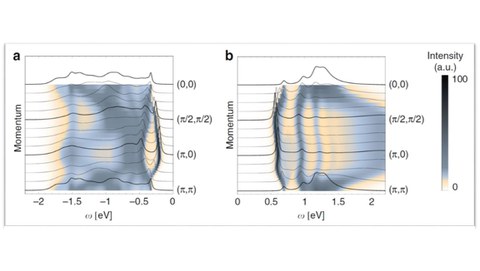09.11.2017
Forschung: Korrelationsbedingte Elektron-Loch-Asymmetrie in Quasi-zweidimensionalen Iridaten
Das Iridat Sr2IrO4 ähnelt in magnetischer und kristallographischer Hinsicht dem Cuprat La2CuO4. Mit Ladungsträgern dotiert, wird das isolierende, antiferromagnetische Kupferoxid La2CurO4 zum Supraleiter mit einer relativ hohen Übergangstemperatur. Dies wirft die Frage auf, wie weit Sr2IrO4 von der Supraleitung entfernt ist, wenn es mit
Ladungsträgern dotiert ist. Der erste Schritt zum Verständnis dieses Themas ist eine Studie uber die Bewegung eines einzelnen Ladungsträgers der in die Struktur eingebracht wird. Unsere theoretische Studie zeigt, dass ein Elektron, das zu Sr2IrO4 hinzugefügt wird, ein Spin-Polaron bildet, ähnlich wie in Cupraten. Entfernt man ein Elektron - bringt also ein zusätzliches Loch ein - dann ist die Situation komplizierter. In diesem Fall entstehen komplexe Vielkörper-Konfgurationen mit Singlet- und Triplet Charakter. Dieser Effekt ist auf die Anwesenheit von starker Spin-Orbit-Kopplung in Iridiumionen in Kombination mit elektronischen Korrelationseffekten zurückzuführen. Als Konsequenz daraus ist das berechnete Fotoemissionsspektrum von Sr2IrO4 (Abbildung) unterschiedlich von seinem inversen Fotoemissionsspektrum. Wir schließen daraus, dass, anders als bei den Cupraten, die elektronische Struktur der Elektronen- und Lochdotierten Iridate grundlegend unterschiedlich sind.
E. M. Pärschke, K. Wohlfeld, K. Foyevtsova, J. van den Brink,
Correlation induced electron-hole asymmetry in quasi- two-dimensional iridates
Nat. Commun. 8: 686 (2017)

